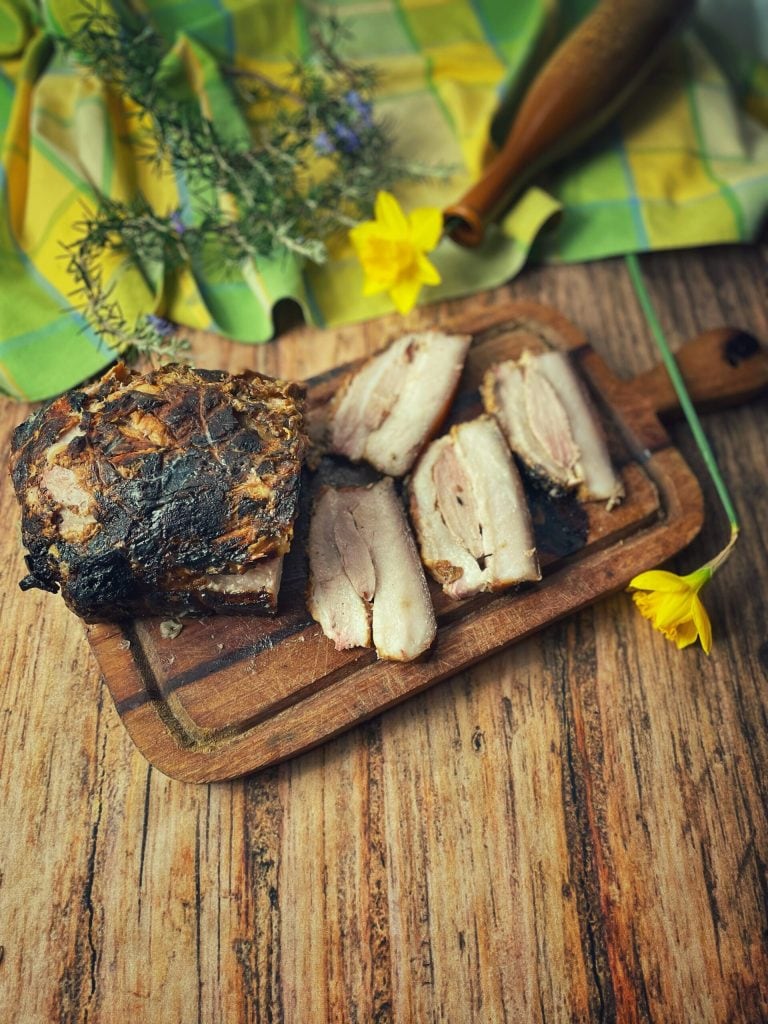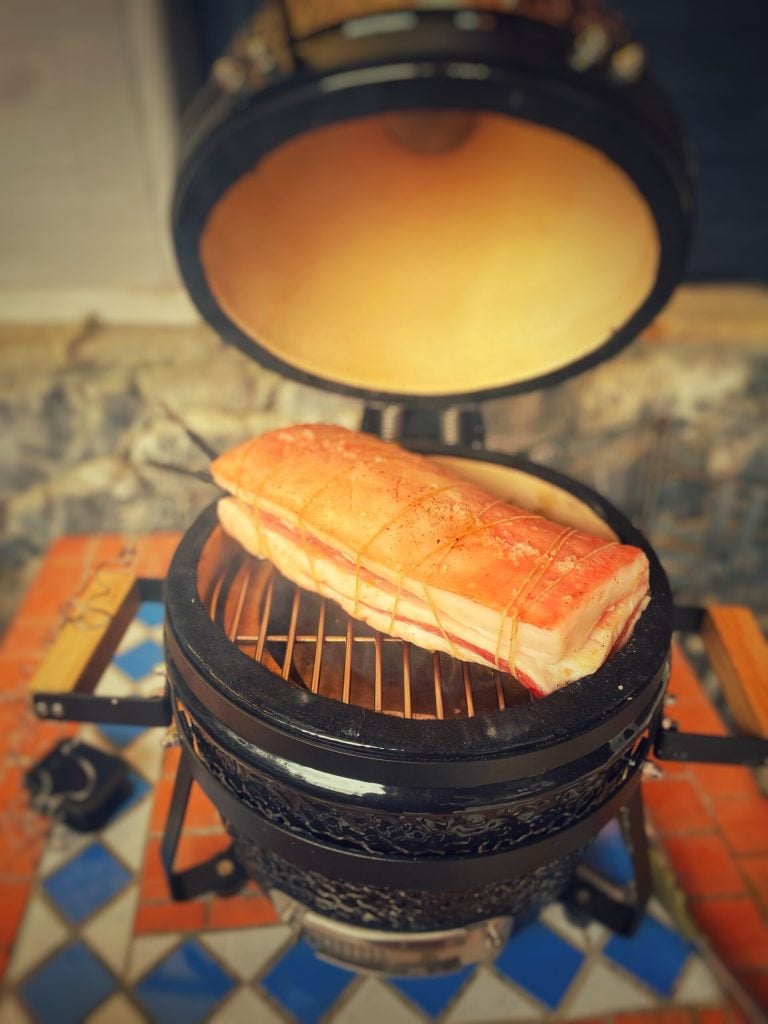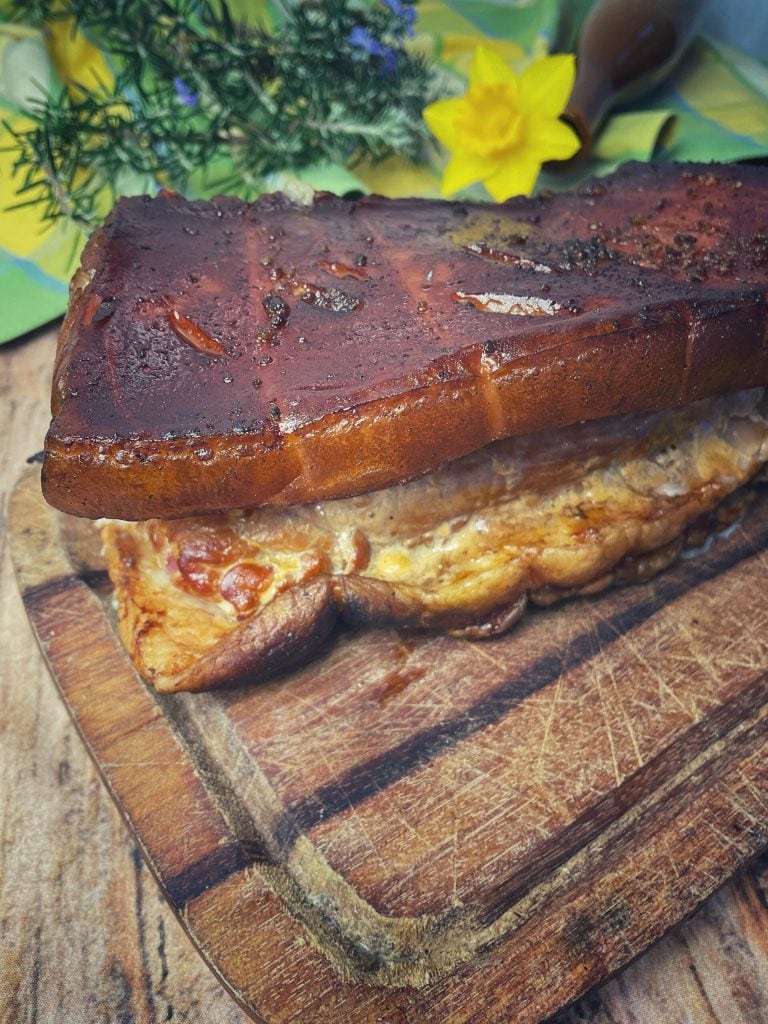Porchetta is a traditional Italian dish of deboned pork, seasoned and usually cooked on a spit or in the oven, this version of mine is porchetta with kamado.
The kamado is a type of traditional Japanese oven or grill, originally used for cooking rice and other foods, but over time it has gained popularity as a barbecue, especially in Western countries.
It consists of a sturdy ceramic or clay structure that maintains and evenly distributes heat.
The round or elliptical shape (often called “egg”) is designed to maximize efficiency in heat distribution and to retain smoke inside, creating an ideal environment for slow cooking.
Thanks to the heat-retaining ceramic, it is ideal for low-temperature cooking and for preparations like pulled pork or brisket.

- Difficulty: Medium
- Cost: Medium
- Rest time: 20 Minutes
- Preparation time: 15 Minutes
- Portions: 6 People
- Cooking methods: Charcoal, Grill, Other
- Cuisine: Italian
- Seasonality: All seasons
Ingredients for porchetta with kamado:
- 2.2 lbs pork belly (preferably with skin)
- 1.1 lbs pork belly
- 4 cloves garlic
- to taste coarse salt
- 1 tbsp whole black pepper
- to taste olive oil
Tools
- 1 kamado
- 1 Thermometer kitchen
Steps
Prepare the meat: take the piece of belly and place it on a work surface with the fatty side (the skin) outward, insert the pork tenderloin, and roll it tightly with kitchen twine as tightly as possible.
Make cuts in the meat, but not too deep, so that the seasoning can penetrate well without breaking the skin.
Marinade and seasoning: finely chop the garlic and in a mortar, crush the whole black pepper, then add some coarse salt and olive oil.Add the garlic. Mix well to obtain a marinade.
Massage the seasoning over all the meat, trying to penetrate well into the cuts of the meat.Let the porchetta rest for at least 1 hour (or even longer if you have time, for a more intense marinade). I marinated it overnight.
Prepare the kamado: light the kamado and bring it to a temperature of 320-356°F.Prepare the kamado for indirect cooking, placing an aluminum bowl under the meat to collect juices, or using a multi-level grill.

If you have the option, you can add some wood to smoke the meat, such as cherry or oak, for an even richer flavor.
Cooking the porchetta: place the porchetta on the kamado, with the skin side up.If the kamado is set for indirect cooking, the meat should cook slowly.
Cook the porchetta for about 2 hours (usually 2 hours per kg), checking the internal temperature.The goal is to reach an internal temperature of the pork belly of 185°F and 162°F for the tenderloin to have well-cooked and tender meat, but with a crispy skin.
During cooking, you can brush the meat with some olive oil occasionally to keep it moist and encourage a crispy crust.
Make the skin crispy: when the meat is almost ready, increase the kamado temperature to 428-464°F to achieve a crispy crust.
You can also move the meat directly onto the grill to ensure even crisping on the skin.
Let it cook for another 5-10 minutes, until the skin becomes golden and crispy.
Rest and serve: once cooked, let the porchetta rest for about 15-20 minutes before slicing. This will help distribute the juices inside the meat.

What are the origins of the kamado?
The kamado has ancient origins and dates back more than 3000 years in Japan.
The kamado has ancient origins and dates back more than 3000 years in Japan.
Initially, it was a wood-fired oven used for cooking rice and other traditional foods.
The term “kamado” derives from the Japanese word “かまど” (which literally means “stove” or “oven”).
The term “kamado” derives from the Japanese word “かまど” (which literally means “stove” or “oven”).
In the past, kamados were typically made of clay and had a shape similar to a large pot or container, with an opening at the top for the entry of heat and smoke.
In the past, kamados were typically made of clay and had a shape similar to a large pot or container, with an opening at the top for the entry of heat and smoke.
In traditional Japanese homes, the kamado was primarily used to cook rice, but also to cook stews, soups, and other slow-cooked dishes or to heat water and prepare broths.
In traditional Japanese homes, the kamado was primarily used to cook rice, but also to cook stews, soups, and other slow-cooked dishes or to heat water and prepare broths.
Today, the kamado is widely used for:
– High-temperature grilling (for cooking grilled meat or pizza).
– Slow cooking (for braising or low-temperature cooking for hours).
– Smoking (thanks to its ability to retain smoke and heat for extended periods).

